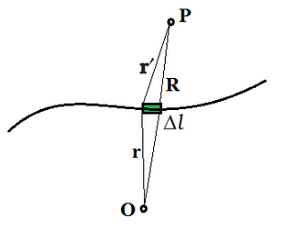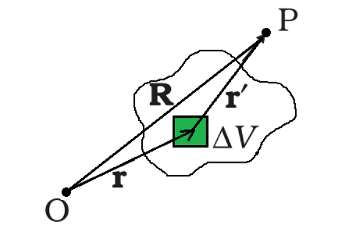Jasmine Grover Study Abroad Expert
Study Abroad Expert
The effect of an electric or magnetic field on elementary particles is controlled by electric charge, which is a fundamental feature of matter. Electric Charge exists in discrete natural units that are neither created nor destroyed. Electric charges are classified into two types: positive and negative charges. When two objects with an excess of one type of charge are placed close enough together, they repel each other. When two negatively and positively charged elements come into close proximity, they attract each other. The property of electric charge is shared by many fundamental or subatomic particles of matter. In this article, we will learn more about continuous charge distribution and the ways in which it is distributed.
| Table of Contents |
Key Terms: Charge density, Electric charge, Electric field, Linear charge density, Surface charge density, Volume charge density, Positive charges, Negetive charges, Charge distribution
Continuous Charge Distribution
[Click Here for Sample Questions]
q1, q2,...,qn are discrete charge combinations that are usually dealt with in a system. One of the reasons we limit ourselves to discrete charges is because the mathematical method is simpler and does not require calculus. Still, for a variety of reasons, working with discrete charges is impractical, thus we must instead employ continuous charge distributions. All charges in a continuous charge distribution are securely linked together with very little space between them.
Charges can be distributed in one of three ways:
- Linear charge distribution
- Surface charge distribution
- Volume charge distribution
Linear Charge Distribution

Linear Charge Distribution
Linear charge distribution occurs when charges are distributed evenly along the length of a conductor, such as around the circumference of a circle or along a straight wire. The symbol λ represents the linear charge distribution.
A wire's linear charge density λ is determined by:
\(\lambda = \frac{\bigtriangleup Q}{\bigtriangleup I}\)
Here, Δl is a little line element of the wire on the macroscopic scale, but it contains a considerable number of microscopic charged components, and ΔQ is the charge contained in that line element.
C/m is the unit used for λ.
Read Also:- Electric Dipole
Surface Charge Distribution

Surface Charge Distribution
The charge distribution on the surface of a charged conductor cannot be described in terms of the positions of the microscopic charged elements. It is more feasible to specify the charge Q on an area element S on the conductor's surface (which, while small on a macroscopic scale, can hold a large number of electrons).
The area element has a surface charge density σ
\(\sigma = \frac{\bigtriangleup Q}{\bigtriangleup s}\)
The macroscopic surface charge density is a smoothed out average of the microscopic charge density across an area element ΔS, which is huge microscopically but small macroscopically, whereas the surface charge density, as stated, ignores charge quantification and charge distribution discontinuities at the microscopic level.
C/m2 is the unit of surface charge density σ.
Volume Charge Distribution

Volume Charge Distribution
Similarly, when a charge is distributed evenly throughout a volume of a surface, such as inside a sphere or cylinder, it is referred to as volume charge distribution ρ.
ρ (also known as charge density) is the volume charge density.
\(\rho = \frac{\bigtriangleup Q}{\bigtriangleup V}\)
It depicts the charge in macroscopically small volume element ΔV which contains numerous microscopic charged elements by the notation ΔQ.
C/m3 is the unit of volume charge density ρ.
Also check:
Field of Continuous charge distribution
[Click Here for Previous Year Questions]
A field of continuous charge distribution can be determined in the same way as a system of field of discrete charges is calculated. Assuming that the continuous charge distribution in the space has a certain charge density. Let r be the position vector of any point in the charge distribution, and O be an acceptable origin. The charge density can vary from one location to another, and it is a function of r. Subdividing the charge distribution into ΔV-sized tiny volume elements. In a volume element ΔV, the charge becomes ρΔV.
Consider any general point P, either inside or outside the distribution, with a position vector R. Coulomb's law calculates the electric field caused by the charge ρΔV,

where r’ denotes the distance between the charge element and P and r' denotes a unit vector pointing from the charge element to P.
The total electric field caused by the charge distribution is calculated using the superposition method, which involves summing the electric fields caused by different volume elements.

Read Also:- Electric Charges and Fields Important Pointers PDF
Types of Charge Distribution
[Click Here for Sample Questions]
| Charge Distribution Type | Denoted by | Value | Unit |
|---|---|---|---|
| Linear | λ (Density of line charges) | ΔQ/Δl where Δl is a small wireline element with microscopic charged components and ΔQ is the line element's charge. | C/m |
| Surface | σ (Density of surface charges) | ΔQ/ΔS ΔS is an area element on the conductor surface, and ΔQ is a charge on that element in the equation. | C/m2 |
| Volume | ρ (Density of volume charges) | ΔQ/ΔV where ΔV is a volume element containing many microscopic components and ΔQ is a charge on that element. | C/m3 |
Also Check:- Verify the laws of parallel combination of resistances using a metre bridge experiment
Previous Year Questions
- In the given circuit, what will be the equivalent resistance between the points…. [JIPMER 2006]
- two charges of equal amount +Q are placed on a line...[WEBJEE 2016]
- The value of A such that the electric field in the region between the spheres will be constant, is….[JEE Main 2016]
- The total energy of a system is...[JEE Main 2018]
- Consider a sphere of radius R which carries a….[JEE Main 2020]
- Which of the following does not show electrical conductance?
Things to Remember
- Electric charge exists in discrete natural units that are neither created nor destroyed.
- Electric charges are classified into two types: positive and negative charges.
- Linear charge distribution occurs when charges are distributed evenly along the length of a conductor.
\(\lambda = \frac{\bigtriangleup Q}{\bigtriangleup I}\)
- The charge distribution on the surface of a charged conductor cannot be described in terms of the positions of the microscopic charged elements.
\(\sigma = \frac{\bigtriangleup Q}{\bigtriangleup s}\)
- Similarly, when a charge is distributed evenly throughout a volume of a surface, such as inside a sphere or cylinder.
\(\rho = \frac{\bigtriangleup Q}{\bigtriangleup V}\)
Also Read:
Sample Questions
Ques. What does it mean to have a linear charge distribution? (3 marks)
Ans. Linear charge distribution occurs when charges are distributed evenly along a length, such as around the diameter of a circle or along a straight wire. The symbol λ represents the linear charge distribution. A wire's linear charge density λ is determined by
\(\lambda = \frac{\bigtriangleup Q}{\bigtriangleup I}\)
Here, Δl is a little line element of wire on the macroscopic scale, but it contains a considerable number of microscopic charged components, and ΔQ is the charge contained in that line element. C/m is the unit of λ.
Ques. A homogeneous charge density exists in a circular annulus with inner radius r and outer radius R. What will the annulus' total charge be? (3 marks)
Ans. The annulus has a total surface area of π×(R2-r2)
It has a radius R on the outside and a radius r on the inside.
The amount of charge stored on a unit surface area is known as the surface charge density. The charge density on the surface is a.
Ques. What are the various types of charge distribution? Give their formulas. (3 marks)
Ans. There are three types of charge distribution:
- Linear charge distribution: = \(\lambda = \frac{\bigtriangleup Q}{\bigtriangleup I}\)
- Surface charge distribution: = \(\sigma = \frac{\bigtriangleup Q}{\bigtriangleup s}\)
- Volume charge distribution: = \(\rho = \frac{\bigtriangleup Q}{\bigtriangleup V}\)
Ques. The linear charge distribution λ distributes a charge along an endless curved line in space. What force will be applied to a point charge q that is kept at a specific distance from the line? (3 marks)
Ans. Let's say the point charge is r distance from a small section dl on the line.
λ.dl is the charge held in the stat tiny section.
That small part's force will be directed towards the unit vector r
As a result, the force exerted on that charge by the complete linear charge distribution can be expressed as
![]()
Ques. A total charge of 10 C is uniformly distributed throughout a solid nonconducting sphere with a radius of 1m. Calculate the sphere's charge density. (3 marks)
Ans. The sphere's volume is equal to (4/3)πr3.
where r is the sphere's radius.
As a result, the charge density is ρ= total charge/[(4/3)πr3].
Using the values as a guide,
ρ = 10/[(4/3)πr3]
ρ= 2.38 C/m3.
For Latest Updates on Upcoming Board Exams, Click Here: https://t.me/class_10_12_board_updates
Check-Out:




Comments